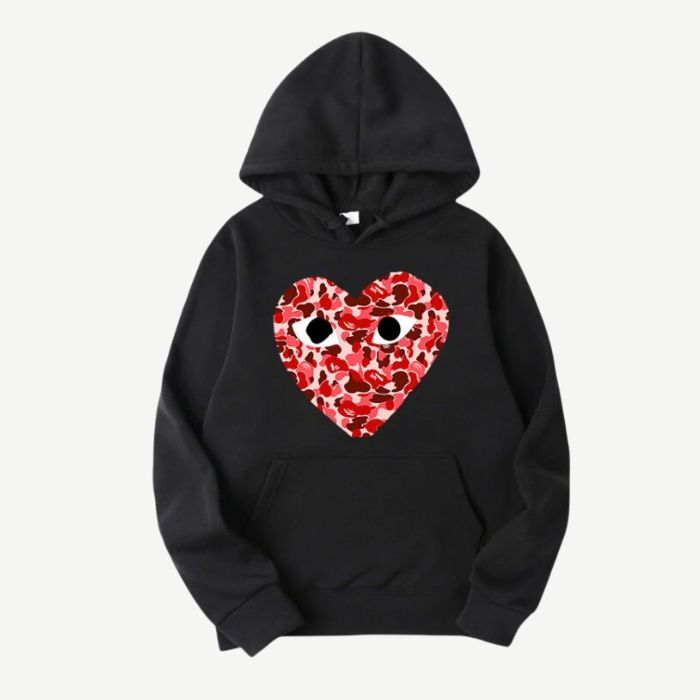Comme des Garçons is one of the most influential brands in the world, revolutionizing the fashion industry with its avant-garde designs and innovative approach. Founded by Rei Kawakubo in Tokyo in 1969, CDG has always been deeply rooted in Japanese aesthetics and design philosophies. Over the years, CDG hoodies have become a staple in streetwear, blending traditional Japanese craftsmanship with modern fashion sensibilities.
Japanese fashion has played a crucial role in shaping the identity of CDG hoodies, incorporating elements such as minimalism, deconstruction, and experimental tailoring. The influence of Japanese culture, aesthetics, and craftsmanship can be seen in every aspect of these iconic hoodies. This article explores how Japanese fashion has shaped the design, production, and cultural impact of CDG hoodies, making them a global phenomenon. commedessgarcon.com
Minimalism and Simplicity in CDG Hoodies
One of the defining characteristics of Japanese fashion is minimalism. Japanese designers have long embraced the philosophy of “less is more,” focusing on clean lines, simple silhouettes, and understated details. This minimalist approach is evident in CDG hoodies, particularly in the CDG Play collection, which features simple designs with the iconic heart logo.
The use of monochromatic colors, especially black, white, and gray, reflects the Japanese aesthetic of understated elegance. CDG hoodies often avoid excessive branding or embellishments, allowing the craftsmanship and fabric quality to take center stage. This minimalistic style makes CDG hoodies versatile and timeless, appealing to both streetwear enthusiasts and high-fashion consumers.
The Influence of Wabi-Sabi on CDG Hoodies
Wabi-sabi, a traditional Japanese aesthetic concept, emphasizes the beauty of imperfection, transience, and simplicity. This philosophy is deeply embedded in CDG’s design language, influencing the way hoodies are constructed and styled. Rei Kawakubo has often incorporated raw edges, asymmetrical cuts, and distressed fabrics into CDG hoodies, embracing the idea that imperfection can be beautiful.
Unlike traditional Western fashion, which often seeks perfection in tailoring and symmetry, CDG hoodies reflect the Japanese appreciation for irregularity. The brand’s experimental approach to fabric manipulation, layering, and draping showcases a unique blend of craftsmanship and artistry, making each hoodie a statement piece.
Deconstruction and Avant-Garde Influence
Japanese fashion has always been at the forefront of deconstructionism, a movement that challenges traditional design norms. Rei Kawakubo is known for her avant-garde approach, breaking down conventional hoodie designs and reconstructing them in unconventional ways.
CDG hoodies often feature exaggerated proportions, inside-out stitching, and unconventional fabric combinations. These design choices reflect the Japanese concept of “Ma” (negative space), where the emptiness or gaps in design are as important as the structure itself. By embracing deconstruction, CDG hoodies stand out as wearable art pieces rather than just casual streetwear.
The avant-garde influence in CDG hoodies has attracted a global following, inspiring other designers and pushing the boundaries of what a hoodie can be. This experimental approach aligns with the Japanese tradition of questioning norms and redefining aesthetics.
Japanese Craftsmanship and Fabric Innovation
Japan has a long history of textile craftsmanship, with techniques passed down through generations. Comme des Garçons embraces this heritage by using premium-quality fabrics and meticulous construction in its hoodies. Many CDG hoodies are crafted in Japan, ensuring high standards of production.
Japanese cotton, known for its durability and softness, is frequently used in CDG hoodies. The country’s advancements in textile technology also allow for the creation of unique fabric textures, from heavyweight fleece to lightweight, breathable blends. This dedication to craftsmanship ensures that CDG hoodies are not only stylish but also long-lasting.
The precision in Japanese garment construction can be seen in the stitching, seams, and overall fit of CDG hoodies. Even in the most experimental designs, the attention to detail remains unmatched, reflecting Japan’s tradition of excellence in craftsmanship.
The Influence of Japanese Streetwear Culture
Japanese streetwear has played a significant role in shaping the global fashion scene, and CDG hoodies are a major part of this movement. The rise of Harajuku fashion in the 1990s and early 2000s introduced a new wave of creativity, blending high fashion with street style. Comme des Garçons became a key player in this cultural shift, influencing both luxury and streetwear brands worldwide.
CDG hoodies are often styled in a way that reflects Japanese street fashion—layered over oversized pieces, paired with unconventional accessories, or combined with bold footwear choices. The ability to mix and match different elements is a core aspect of Japanese streetwear, allowing individuals to express their creativity through clothing.
Furthermore, Japanese streetwear brands like A Bathing Ape (BAPE), Undercover, and Visvim have drawn inspiration from CDG’s avant-garde approach, further cementing its impact on fashion. The fusion of streetwear and high fashion, now seen globally, originated from the experimental and rebellious spirit of Japanese designers like Rei Kawakubo.
The Global Appeal of Japanese-Inspired CDG Hoodies
Although CDG hoodies are deeply influenced by Japanese design principles, their appeal extends far beyond Japan. Celebrities, artists, and fashion enthusiasts worldwide have embraced these hoodies as symbols of individuality and artistic expression.
The global rise of Japanese pop culture, including anime, manga, and J-pop, has also contributed to the popularity of CDG hoodies. The CDG Play heart logo, with its cartoonish eyes, resonates with fans of Japanese visual culture, making the brand even more recognizable.
International collaborations with brands like Nike, Supreme, and Converse have further expanded the reach of CDG hoodies, bringing Japanese fashion aesthetics to a wider audience. These collaborations maintain the essence of CDG’s design philosophy while making the brand more accessible to streetwear enthusiasts around the world.
CDG Hoodies and the Philosophy of Individuality
Japanese fashion celebrates individuality, and Comme des Garçons embodies this philosophy in its hoodie designs. Unlike mainstream brands that follow seasonal trends, CDG operates outside of conventional fashion cycles, creating pieces that remain timeless.
CDG hoodies encourage self-expression, allowing wearers to style them in unique ways. Whether paired with tailored pants for a high-fashion look or worn casually with sneakers, these hoodies adapt to different personalities and aesthetics. This emphasis on individuality aligns with the Japanese fashion principle of “Jibun-rashisa” (being true to oneself).
Rei Kawakubo has always challenged traditional beauty standards, encouraging people to embrace unconventional silhouettes, layering techniques, and asymmetry. This philosophy is deeply embedded in CDG hoodies, making them more than just garments—they are statements of self-expression.
Travis Scott x Nike: A Look at the Iconic Hoodie Collaborations
Travis Scott has established himself as a dominant force in both music and fashion, seamlessly blending his creative vision into streetwear culture. His collaborations with Nike have been nothing short of groundbreaking, with each release generating immense hype and demand. While much of the attention often goes to his sneaker collaborations, his hoodie collections with Nike have also played a crucial role in defining his impact on street fashion. These hoodies embody his signature aesthetic, blending sportswear with rugged, earthy tones, unique graphics, and high-quality materials.
This article explores the evolution of Travis Scott’s hoodie collaborations with Nike, highlighting the design elements, cultural impact, and why these pieces continue to be some of the most sought-after items in streetwear today.
The Origins of Travis Scott x Nike Collaborations
Travis Scott’s relationship with Nike began in 2017, when he was tapped to create a special edition of the Air Force 1. This partnership quickly evolved into one of the most influential collaborations in contemporary streetwear. Unlike typical artist-brand partnerships, Scott’s involvement extended beyond sneakers, leading to the development of full apparel collections, including hoodies that perfectly encapsulated his unique design philosophy. travisofficialshop.com
Nike’s decision to collaborate with Travis Scott was a strategic move, capitalizing on his influence within both music and fashion. His ability to shape trends and redefine style made him an ideal partner, and the success of their projects reinforced the power of artist-driven streetwear.
Conclusion
The influence of Japanese fashion on CDG hoodies is undeniable. From minimalism and deconstruction to high-quality craftsmanship and streetwear innovation, these hoodies represent a fusion of tradition and modernity. Comme des Garçons has successfully translated Japan’s design philosophies into a global fashion movement, redefining the way hoodies are perceived and worn.
By embracing elements of wabi-sabi, avant-garde experimentation, and premium textile craftsmanship, CDG hoodies stand out as some of the most distinctive pieces in the world of streetwear and high fashion. Their impact continues to grow, shaping trends and inspiring designers across different cultures.
As Japanese fashion continues to influence the global industry, CDG hoodies remain a symbol of artistic expression, individuality, and the perfect blend of heritage and innovation.









